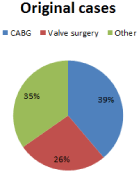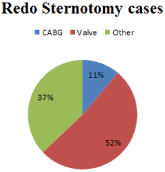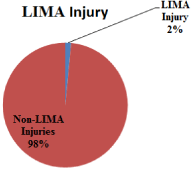
Research Article
Ann Surg Perioper Care. 2016; 1(1): 1001.
Effect of Repeat Sternotomy on Cardiac Surgery Outcomes
Lemaire A*, Batsides G, Saadat S, Ghaly A, Nishimura T, Volk L, Spotnitz A and Lee LY
Division of Cardiothoracic Surgery, Department of Surgery, RUTGERS-Robert Wood Johnson Medical School, 125 Paterson Street, New Brunswick, New Jersey, 08903, USA
*Corresponding author: Anthony Lemaire, Assistant Professor, Division of Cardiothoracic Surgery, Department of Surgery, RUTGERS-Robert Wood Johnson Medical School, 125 Paterson Street, New Brunswick, New Jersey, 08903, USA
Received: August 05, 2016; Accepted: September 02, 2016; Published: September 06, 2016
Abstract
Purpose: To determine the impact of repeat sternotomy after adult cardiac surgery on surgical outcomes. The primary endpoints include operative mortality and rate of reoperation for bleeding.
Methods: A retrospective review of prospectively collected data from a single institution. The patients underwent coronary artery bypass grafting (CABG), valvular surgery, CABG and valvular surgery and other procedures from July 1st, 2011 to December 31st, 2013. Charts were evaluated for demographics, operative details and postoperative outcomes. Operative mortality was defined as death within 30-days of surgery.
Results: We identified 165 patients who underwent 170 total adult cardiac surgery procedures. The average age of the patients was 68.93 ± 13.3 and the majority of the patients were male (N=116). The patient’s original surgical procedures were predominantly CABG (39%), with the remaining patients having undergone valvular surgery (26%), and other procedures (35%) including insertion of a left ventricular assist device (Figure 1). Of the redo-sternotomy procedures the majority of patients underwent valvular surgery (52%) either multiple valve procedures or combination of CABG and valvular surgery. The remaining patients had other procedures (37%) performed including orthotropic heart transplantation, and the rest underwent CABG (11%) (Figure 2). The mortality rate was 7% for the entire group with 4% mortality for aortic valve replacement (AVR), 3% for mitral valve procedures and 0% for CABG. The rate of reoperation for bleeding was 2.4% for the entire group with 1.9% for AVR, and 0% for CABG.

Figure 1: The percentage of original cases within the patient population.
Conclusions: Repeat sternotomy has increased risk for patients undergoing adult cardiac surgery. The data from our study shows that the patients who underwent redo-sternotomy had low mortality and the rate of reoperation is low at 2.4% for postoperative bleeding. Although the risks are enhanced with the proper preparation patients can have successful outcomes.
Introduction
The elderly population in the Western world is growing exponentially. By 2025 there will be more than 150 million people older than age 80 and by 2050 there will be more than 370 million people above 80 years old [1]. With the growing elderly population, there is increasing management of patients who have already undergone cardiac surgery. As the population continues to age, progression of disease, and failure of prosthetic valves contribute to re-operation in up to 15-20% of all heart operations [2]. Consequently, adult cardiac surgeons are now challenged with operating on more patients with a previous sternotomy. Sternal reentry potentially increases the risk of injury to the heart or great vessels leading to severe blood loss or death. The perceived risks sometimes results in patients being denied surgery. Indeed one of the publicized benefits of transcatheter aortic valve replacement is the avoidance of a repeat sternotomy. Furthermore, patients with coronary artery disease who have previously undergone open heart surgery are often encouraged to undergo percutaneous coronary artery interventions to avoid surgery.
In the pediatric population, repeat sternotomy is very common and cardiac surgeons routinely perform surgery on children with previous sternotomies. In the adult population however, sternal reentry is often avoided and the actual risk of repeat sternotomy is not entirely clear in the literature. The purpose of the study is to determine the effect of repeat sternotomy on cardiac surgery outcomes.
Methods
From July 1st 2011 to December 31st, 2013 a retrospective review of prospectively collected data from a single institution was performed. The patients underwent coronary artery bypass grafting (CABG), valvular surgery, CABG and valvular surgery and other procedures from July 1st, 2011 to December 31st, 2013. Charts were evaluated for demographics, operative details and postoperative outcomes. Operative mortality was defined as death within 30-days of surgery. The study was approved by the Institutional Review Board.
Results
We identified 165 patients who underwent 170 total adult cardiac surgery procedures. The average age of the patients was 68.93 ± 13.3 and the majority of the patients were male (N=116). The patients’ original surgical procedures were predominantly CABG (39%), with the remaining patients having undergone valvular surgery (26%), and other procedures (35%) including insertion of a left ventricular assist device (Figure 1). Of the redo-sternotomy procedures the majority of patients underwent valvular surgery (52%) either multiple valve procedures or combination of CABG and valvular surgery. The remaining patients had other procedures (37%) performed including orthotropic heart transplantation, and the rest underwent CABG (11%) (Figure 2). The mortality rate was 7% for the entire group with 4% mortality for aortic valve replacement (AVR), 3% for mitral valve procedures and 0% for CABG. The rate of reoperation for bleeding was 2.4% for the entire group with 1.9% for AVR, and 0% for CABG.

Figure 2: The percentage of Redo sternotomy cases within the patient
population.
Despite the majority of the patient having undergone CABG, the injury rate of the previous bypass grafts was low. Only 2 vein grafts and 1 left internal mammary artery were injured making the percentage of injured grafts, 3% and 2%, respectively for the patients who had CABG as their first surgery (Figure 3 and 4). Other complications were identified including injury to the right atrium (N=1), right ventricle (N=1), and injury to the outflow graft from the left ventricular assist device (Table 1). Furthermore, the redosternotomy cases were not only 1st time (N=158) redo cases but 12 patients had 2nd redo sternotomies and 3 patients had 3rd time redo cases. Despite the multiple repeat sternotomies the patients overall did well.
Injury
N
Vein Grafts
2
LIMA
1
Right Atrium
1
Right Ventricle
1
Outflow Graft
1
Table 1: Intraoperative Complications.

Figure 3: Three percent of the vein grafts were injured within all the original
CABG patients.

Figure 4: Two percent of the LIMA conduits were injured.
Although the mortality and complication rates were low there was an increase in length of stay (LOS) seen in the patients who had redo sternotomies (Table 2). The average LOS was 18.8 days for the patients that underwent redo sternotomies and 12.2 days for the primary sternotomy cases at our institution. An explanation for the longer LOS could be contributed to the increased time it takes to recover from the additional sternotomy. In addition, perhaps the patients who underwent the primary cases were younger and had less co-morbidity and therefore recovered faster and were discharged earlier. Another factor that we saw was that the patients who underwent redo sternotomies required more blood products than those patients who had primary sternotomy at our institution (Table 3). A total of 45.1% of the patients that underwent redo sternotomies required blood transfusions compared to 41.6% of the primary cases intraoperatively. The redo patients also received more fresh frozen products and cryoprecipitate compared to the primary sternotomy patients at our institution. These findings are consistent with what we would expect since there is often more coagulopathy and bleeding in the redo sternotomy cases.
Average LOS
Total Procedures
1st Surgery
Redo Sternotomies
ALL CTS Procedures
12.7
12.2
18.8
Isolated AVR
10.8
10.1
14.9
Isolated CABG
10.7
10.6
15.9
Table 2: Length of Stay.
The operative procedures were diverse given the multiple cardiothoracic surgeons at the institution. There were 23 ministernotomies of the 170 cases performed (13.5%), and 137 of the cases (80.5%) involved cut down of the femoral vessels prior to performing the redo-sternotomies. The femoral vessels were exposed in the event that cardiopulmonary bypass (CPB) was required emergently. On review of the operative data there were no cases where the patients underwent CPB prior to the redo-sternotomy. This is a known option employed by certain surgeons to avoid injury and prevent catastrophes.
Intraoperative Blood
Total Procedures
1st Surgery
Redo Sternotomy
RBC
41.6%
42.5%
45.1%
FFP
20.9%
21.0%
25.9%
Cryo
6.7%
6.5%
8.1%
Platelet
27.1%
29.9%
20.9%
Table 3: Transfusions.
Discussion
With a rising elderly population and improvement in surgical management of disease, patients are living longer after cardiac surgery and facing increasing preoperative risks. Currently, the presence of a previous sternal incision from an original open heart operation is a risk factor for surgery in the Society of Thoracic Surgeons (STS) risk assessment. Our data indicates that the risk associated with surgery is not as significant as once thought. Our mortality data shows that overall mortality was low at 7%; specifically we had 0% mortality for redo-sternotomy for CABG, 4% mortality for AVR, and only 3% mortality for mitral valve procedures. In addition to the low mortality we also demonstrate that the complication rate for these cases is small. There were only 7 operative complications that involved injuring a bypass graft or the heart itself. The heart structures itself were injured in 2 cases (right atrium and right ventricle (1.1%).Our data is far lower than that previously reported in the literature where the risk of intraoperative injury to cardiac structures can occur in 5% to 10% of repeat sternotomies [3-5].
AVR is one of the most commonly performed cardiac surgery procedures. The literature reports mortalities for re-operative AVR to range from 5.9% to 14% [6]. Our data shows mortality at only 4%. Similarly, previous clinical series have reported morality rates between 6% and 18% for reoperative mitral valve operations [4,5] however our data showed mortality to be only 3% for similar cases. The most common original procedure was CABG for the majority of patients and one of the common concerns is damaging the bypass grafts and therefore interrupting the revascularization of the heart. Our data demonstrates that with careful sternal re-entry the risk of injuring the bypass conduits are low with only 2 vein graft injuries (3%) and 1 LIMA (2%) injury. The notion that the risk of redo-sternotomy is not as extreme as previously considered is supported by others in the literature. Lytle et al. [7] reported 3 deaths among 1500 coronary re-operations due to complications of repeat mediansternotomy. The risk of injury to a patent internal thoracic artery graft has been reported in 2 series: one by Lytle et al, with reported damage in 3.5% of 489 patients, and the other by Baillot et al [8], reporting a rate of 8% among 100 cases. In our study we only identified 1 patient who had injury of the LIMA (2%).
One of the techniques of minimizing surgical risk during repeat sternotomy is performing a hemi-sternotomy and avoiding the full median sternotomy. The benefit is that you reduce the amount of mobilization of the heart and therefore decrease the potential for injury. This has been shown by Tabata M. et al, that upper hemisternotomy avoids dissection of the mediastinum and limits bleeding and blood transfusion [9]. The right mini-thoracotomy approach for patients with previous sternotomies has been detailed before in the literature [1]. The benefits have included a shorter length of stay, less pain, shorter ventilation duration, less blood loss and transfusion requirements [10,11].
The process of sternal re-entry is very complex and it involves careful preparation and appropriate technique. The use of preoperative computerized tomography (CT) scans and potentially femoral – femoral bypass is dependent on the individual surgeon and has varied results. The use of a CT scan is thought to help identify the relationship between the sternum and the heart. This is thought to allow for more careful sternal re-entry.
Taken together, repeat sternotomy has some increased risk for patients undergoing adult cardiac surgery. The data from our study shows that the patients who underwent redo-sternotomy had low mortality and the rate of reoperation for postoperative bleeding is low at 2.4%. Although the risks are enhanced with the proper preparation patients can have successful outcomes.
References
- Pineda AM, Santana O, Reyna J, Sarria A, Lamas GA, Lamelas J. Outcomes of reoperative aortic valve replacement via right mini-thoracotomy versus median sternotomy. J Heart Valve Dis. 2013; 22: 50-55.
- Merin O, Silberman S, Brauner R, Munk Y, Shapira N, Falkowski G, et al. Femoro-femoral bypass for repeat open-heart surgery. Perfusion. 1998; 13: 455-459.
- Launcelott S, Ouzounian M, Buth KJ, Legare JF. Predicting in-hospital mortality after redo cardiac operations: development of a preoperative scorecard. Ann Thorac Surg. 2012; 94: 778-784.
- Park CB, Suri RM, Burkhart HM, Greason KL, Dearani JA, Schaff HV, et al. Identifying patients at particular risk of injury during repeat sternotomy: analysis of 2555 cardiac reoperations. J Thorac Cardiovasc Surg. 2010; 140: 1028-1035.
- Ellman PI, Smith RL, Girotti ME, Thompson PW, Peeler BB, Kern JA, et al. Cardiac injury during resternotomy does not affect perioperative mortality. J Am Coll Surg. 2008; 206: 993-997.
- Akins CW, Buckley MJ, Daggett WM, Hilgenberg AD, Vlahakes GJ, Torchiana DF, et al. Risk of reoperative valve replacement for failed mitral and aortic bioprostheses. Ann Thorac Surg. 1998; 65: 1545-1551.
- Lytle BW, Loop FD, Cosgrove DM, Taylor PC, Goormastic M, Peper W, et al. Fifteen hundred coronary reoperations. Results and determinants of early and late survival. J Thorac Cardiovasc Surg. 1987; 93: 847-859.
- Baillot RG, Loop FD, Cosgrove DM, Lytle BW. Reoperation after previous grafting with the internal mammary artery: technique and early results. Ann Thorac Surg. 1985; 40: 271-273.
- Tabata M, Khalpey Z, Shekar PS, Cohn LH. Reoperative minimal access aortic valve surgery: minimal mediastinal dissection and minimal injury risk. J Thorac Cardiovasc Surg. 2008; 136: 1564-1568.
- Pineda AM, Santana O, Zamora C, Benjo AM, Lamas GA, Lamelas J. Outcomes of a minimally invasive approach compared with median sternotomy for the excision of benign cardiac masses. Ann Thorac Surg. 2011; 91: 1440-1444.
- Byrne JG, Aranki SF, Couper GS, Adams DH, Allred EN, Cohn LH. Reoperative aortic valve replacement: partial upper hemisternotomy versus conventional full sternotomy. J Thorac Cardiovasc Surg. 1999; 118: 991-997.